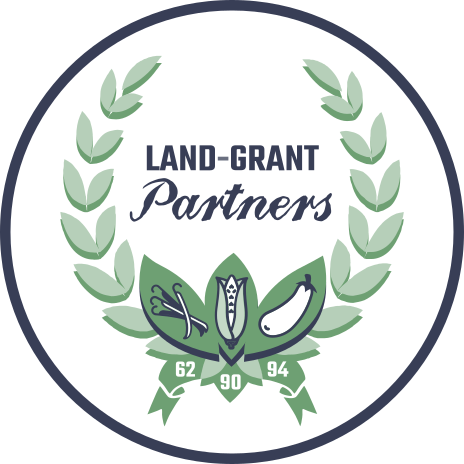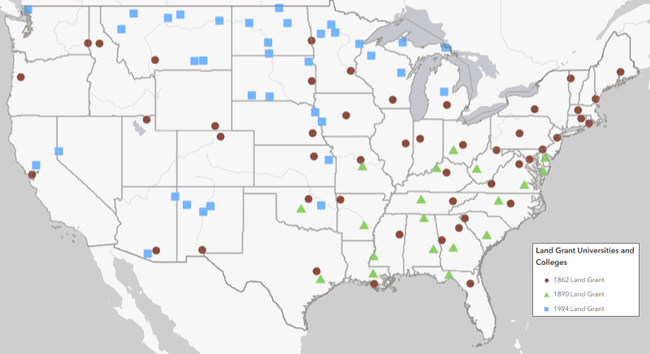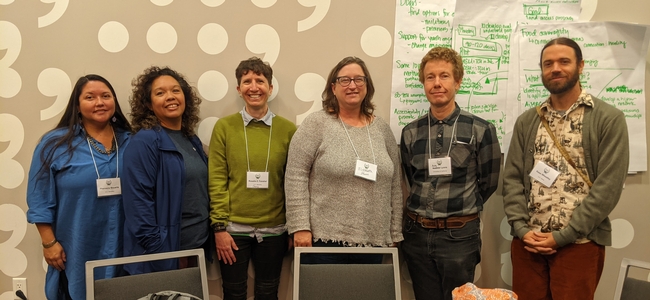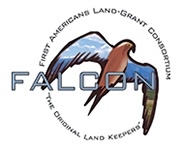A copy of this blog post can also be found on the Together@Work blog.

The Summit was held immediately before the 2023 FALCON (First Americans Land-Grant Consortium) Conference, another great conference which brings together hundreds of administrators, faculty, extension educators, researchers and students who work on land grant programs at TCUs and share program successes. Both meetings were amazing. While FALCON has been around for 19 years, this was only the second national meeting of the Land-Grant Partners consortium, and it was our first time at either event.
Three Generations of Land Grant Institutions
We felt in good company being with so many people working in land grant institutions all over the country. But seriously, what's with all the dates?
What all land grants have in common is a mission to support communities, agriculture, and natural resources through research and extension. However it was immediately apparent that most of the presentations, and even the conferences themselves, were structured around the three groups of land grant institutions which have become known by the year that federal legislation provided the initial funding: 1862, 1890, and 1994.
The 1862s are land grant universities that were established by the 1862 Morrill Act. This act gave ‘public lands' to every state, most of which was sold to create endowments for universities with programs in agriculture and engineering. Today, these are mostly the big state schools, like the University of California or Penn State, where Cooperative Extension programs are run from. The 1890s are historically Black Colleges and Universities, which Congress had to establish through separate legislation because the 1862 schools discriminated against people of color. Finally, more than a hundred years later, Congress finally provided funding in 1994 to support Tribal Colleges and Universities, collectively known as the 1994s or TCUs.

Click on the map to go to an interactive web map of the 1862, 1890, and 1994 land grant institutions
Source: USDA
Why all the fuss about the three generations of land grant institutions? Well, the sad reality is that although 1862s, 1890s, and 1994s all have similar missions, there are enormous gaps in how much funding they receive from federal and state sources. Not surprisingly, this results in unequal levels of resources for research and extension, and ultimately fewer programs for Native Americans and other people of color. This is precisely the nut the LGP and FALCON alliances are trying to crack.
Land-Grant Partners Summit
Most of the attendees at the LGP Summit were from 1862 institutions, with a handful of TCUs, federal agencies, and federally funded programs. Many 1862s are trying to do a better job serving Native Americans. This is in line with their mission to serve the entire public, and in recognition that there has been a huge gap for generations. Since 2020, the call for 1862s to try harder has grown louder, informed by research detailing how they got their start by selling millions of acres of stolen Indian land (Lee and Ahtone, 2020), and widespread national interest in dismantling structural inequality.
Everyone attending the LGP Summit knew this history, and although it needs to be told to a lot more people the focus of the Summit was looking forward. It was exciting to be with so many kindred spirits, to hear what other 1862s are doing, and think about how we can be more effective working together than individually. Some of the leaders in the movement include The Ohio State, which has started a program to reach tribes that were forcibly removed from Ohio, and South Dakota State University, which has diverted funding from its Morrill Act lands to support Native American students and collaborations with Tribal Colleges.
UC in the House
Although the University of California is not at the head of the pack when it comes to spearheading reconciliation and collaboration with Tribes, the ball is definitely rolling. It was wonderful to connect with new and old UC colleagues from UC Berkeley, UC Davis, and UC ANR, to hear what everyone is working on, and think about how we can work together more effectively. There are no shortages of ideas, and many faculty, students, and programs across UC are already doing amazing work to foster understanding and provide support for Native American students and other underserved populations.
However the goal will not be reached through celebrating the work of a few individuals. Rather, we need to shift UC as an institution - its policies, priorities, governance, incentive structures, resource allocation, and culture - so that the hard but rewarding work of healing and learning from Tribes is not the exception but the norm.

Making Spaces for Native Voices
A cross-cutting theme expressed in many sessions was the importance of including Native Americans as co-equal partners in designing and developing university programs and policies. Without Native voices at the table, and in meaningful leadership roles, we run the risk of planning programs with the same paternalistic processes that are well intentioned but ultimately fail to produce results. This is hard work, particularly within a university setting where administrators and academics are used to thinking a certain way, and doing things a certain way. But by learning from others, working together, and listening to those our institution owes a debt to, we can become a better university.
Sponsors and Collaborators of the 2023 Land-Grant Partners Summit





